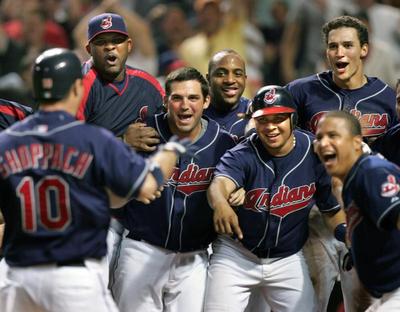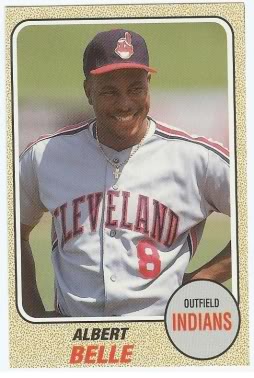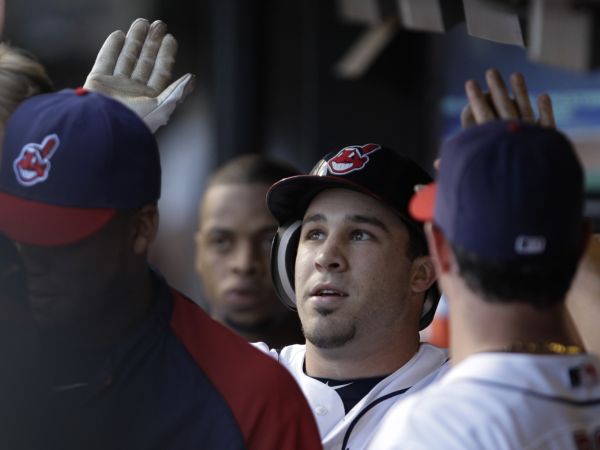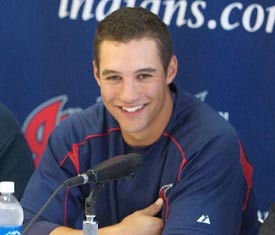 Indians Archive
Indians Archive  Repeating History on A Lazy Sunday
Repeating History on A Lazy Sunday

As horrible as this off-season has been for Indians fans as we feel like that kid looking out of the window at recess time, watching everyone else have so much fun while we sit quietly away from all of the action, let’s attempt to gain some perspective again, if only to combat the pervasive “the Indians are on the cusp of walking through the desert for another 40 years” rhetoric that has become accepted as fact locally and (at least when they mention the Tribe) nationally.
Is it depressing to see three of the four other AL Central teams making prudent, high-upside deals as the Twins retain Pavano and Thome (at reasonable numbers and years) while adding a middle-infield import that should upgrade their team, as decimated as their bullpen has been with departures?
Of course, just like it’s painful to acknowledge the fact that the White Sox and Kenny Williams put on their annual rabbit-out-of-the-hat off-season, signing Adam Dunn to the deal that I think most will look back on as the best deal of the off-season, retaining Paul Konerko, replacing Fat Bobby Jenks with Jesse Crain, and keeping what looks like the best rotation in the AL Central intact and potentially healthy?
As much fun as it is to think about everything that could go wrong in Motown (with their perpetual “we’ll think about tomorrow some other time” contracts), even the Royals overcame their initial stumble out of the gates (with Francouer and Melky) to add some rotational fodder in Francis and Chen to deals that I wouldn’t have minded seeing the Indians taking on?
Even going outside of the AL Central, news that the Rockies signed Joe Crede to a Minor League deal has Tribe fans wondering why Jack Hannahan will be in Goodyear this Spring and not Crede, given the nature of both signing Minor League deals. Forget that I spend some days convinced that Jack Hannahan is going to be the 3B out of Spring Training because everyone else who is a candidate there feels like a square peg/round hole situation.
There’s plenty of time to get to that though as the season approaches and once the season starts and begins to flesh out as the performances of Francis and Chen will be on display in our division and the paths that Crede and Hannahan take in 2011 will be obvious once April begins. For now, let’s get into a Lazy One as I don my little green visor (Google tells me it is a “green eyeshade”) and pull out my leather-bound ledger to get off on some Tribe talk and run some numbers and attempt to provide some context for those numbers.
The reason that numbers and calculators come up coincides with the big news of the week of the arbitration signings and how they, in effect, set the 2011 payroll somewhere around $46M or so, and I’ll use the $46,413,000 that the IPI salary chart lists.
As I pull my hair out, let me just shreik “OH THE HUMANITY!”...am I doing this right?
Kidding aside and thinly-veiled shots at the “DOLANZ R CHEEP” crowd out of the way, take a deeper look at that link to IPI and check the salaries by year for the Tribe, with the last decade looking like this, with the inclusion of 2000 being important because it represents the first full year of Dolan ownership, but also because the 2000 payroll it was the highest payroll in Indians’ history…until the next year, when the Dolans would once again preside over the highest payroll in Tribe history. For your enjoyment, here’s an interesting link to an announcement of the sale in November of 1999, full of tidbits that I just don’t remember.
Nevertheless, here’s the payroll by year:
2011: $46,416,000
2010: $61,453,967
2009: $81,579,166
2008: $78,970,066
2007: $61,673,267
2006: $56,031,500
2005: $41,502,500
2004: $34,319,300
2003: $48,584,834
2002: $78,909,499
2001: $93,360,000
2000: $76,500,000
If you want to go back further, you can see that the shining beacon of Cleveland baseball, Mr. Dick Jacobs, presided over a payroll of $8,236,166 in 1992, which was less than half of the 4th lowest payroll of the Orioles.
Seriously, check this list out...
Of course, that 1992 team had guys like Albert Belle, Carlos Baerga, Kenny Lofton, Sandy Alomar, Jr., Jim Thome, Charles Nagy, and Jose Mesa on the team that would finish 76-86 and still reek of unrealized potential and with the team’s highest paid players being Felix Fermin ($950K) and Joel Skinner ($700K)...no, really.
 But wasn’t that the “Original Plan” back in the mid-1990s...to assemble a massive amount of young talent, allow the wheat (Thome, Belle, etc.) to separate from the chaff (Glenallen, Whiten, Jack Armstrong, etc.) and sign the players that distinguished themselves to long-term deals?
But wasn’t that the “Original Plan” back in the mid-1990s...to assemble a massive amount of young talent, allow the wheat (Thome, Belle, etc.) to separate from the chaff (Glenallen, Whiten, Jack Armstrong, etc.) and sign the players that distinguished themselves to long-term deals?
The payrolls increased slowly (1993 - $15.72M, third lowest in MLB for a team that would go 76-86 again; 1994 - $28.49M, 10th lowest in MLB in strike-shortened season and so on) as the players that the Indians identified as “core” players accumulated service time and were paid at higher rates (usually with long-term deals that gave them up-front money while buying out FA years) as the years progressed. As much as everyone remembers the Indians of the late-1990s, with John Hart wheeling and dealing and the Indians being major players on the FA market (thanks to the revenue stream provided by a new ballpark), the way that the Renaissance of baseball in Cleveland started was the accumulation of young near-MLB-ready alent and the identification of certain players as a “core” to build around.
As I remember, it worked out pretty well from those humble beginnings, essentially rescuing baseball in Cleveland and setting the stage for the “Golden Age” of the franchise. Not to continue to bore you with history as I’m sure you’re aware of all of this, stay with me here and take a look at what happened after the Indians started anew in the early-to-mid-2000s, after the roster had been purged and the majority of high priced “talent” found themselves elsewhere. Remember that whole idea that the optimistic view of the 2011 season would be to duplicate the performance of the 2004 team (80-82), with certain young players stepping forward with significant production?
Well, since most of the criticism of the Indians is that their roster consists of veteran question marks, a couple of players who are underpaid (by virtue of service time) and league-minimum fodder, check this:
2004 payroll - $34,319,300
Here’s the list of players on that 2004 team that DIDN’T simply make the league minimum:
Matt Lawton - $7.25M
Omar Vizquel - $6.25M
Bob Wickman - $6M
CC Sabathia - $2.7M
Ronnie Belliard - $1.1M
David Riske - $1.025M
Jake Westbrook - $925K
Lou Merloni - $560K
Scott Elarton - $480K
Tim Laker - $450K
Every other player on the team made $352K or less, including Hafner, Victor, Clifton Phifer and Blake.
What about the following year, for the team that won 93 games?
2005 payroll - $41,502,500
Again, here is the list of players on the 2005 team that made more than the league minimum:
Kevin Millwood - $7M
CC Sabathia - $5.25M
Arthur Rhodes - $3.7M
Aaron Boone - $3M
Jake Westbrook - $2.9M
Bob Wickman - $2.75M
Ronnie Belliard - $2.5M
Casey Blake - $2.25M
Jose Hernandez - $1.8M
David Riske - $1.425M
Alex Cora - $1.3M
Bob Howry - $900K
Scott Elarton - $850K
Victor Martinez - $700K
Juan Gonzalez - $600K
Scott Sauerbeck - $500K
As a quick aside here, do you notice where a lot of the money is spent on that 2005 team – in an attempt to construct a bullpen because of a lack of internal options? There is $9.25M on that list being paid to relievers (only one of which was “homegrown” in Riske), meaning that 22% of the payroll was tied up in 4 relievers as the Indians attempted to cobble together a bullpen, perhaps providing a glimpse at what would be the Achilles’ heel of the team for the next few years...if not 2005 specifically. To that end (and I know I’ve hit on this before as have others), the Indians certainly seem to be putting much more of an emphasis on that “homegrown” bullpen, with Jordan Bastian hitting on a couple of relevant names with some great information in this piece that lends some credence to the idea that a lesson was at least learned in terms of bullpen construction in the mid-2000s to what we see today.
Nevertheless, back to that 2005 payroll, realize that (again) Hafner and Lee find themselves below the names on list above, now joined by Sizemore and Peralta, among others on that 2005 team as players being paid league minimum on a 93-win team that had a $41.5M payroll.
What was that 2011 payroll looking like...$46M or so?
Compare the lists above to the one provided by Bastian of players on the 2011 Indians that will be pulling in paychecks above league minimum:
2011 payroll - $46,416,000
Again, these are the players that will be paid salaries higher than the league minimum:
Travis Hafner - $13M
Grady Sizemore - $7.5M
Fausto Carmona - $6.1M
Shin-Soo Choo - $3.975M
Chris Perez - $2.225M
Asdrubal Cabrera - $2.025M
Rafael Perez - $1.33M
Austin Kearns - $1.3M
Joe Smith - $870,000
Jensen Lewis - $650,000
Anyone else notice that the number here (10) is the same number on the 2004 team that was paid above league-minimum salary?
Probably not, but I think you understand where this is attempting to go in providing some context with the last two “rebuilding” processes that the Indians undertook at the beginning of the 1990s and the beginning of the 2000s.
While the success of those two rebuilds is public record (and the sustenance of the rebuilds is the main separator, though not the only one), so is the salaries associated with the players that keyed those rebuilds and the manner in which the team built a team from the bottom up. Whether what we’re currently experiencing is going to replicate the “success” (as lasting or as fleeting as that may be) will be ultimately be determined by the talent on hand or just beneath the surface.
Ultimately, it’s on the young minimum-salary players to prove that they’re “core” players just like those linchpins of the 1990s did and the way that the players that we just said goodbye to did in the mid-2000s.
 Around the diamond and on the mound, the Indians seem to have options that have shown enough talent to be highly considered – and just recently Chisenhall was named the 2nd highest rated 3B in MiLB, with Kipnis being ranked as the 4th highest rated 2B in MiLB and thank goodness because the situations at those positions are horrifying, made worse with the news last week that the Indians are considering moving Donald to 3B and made somewhat palatable when Andrew Humphries at LGT invoked every vaudeville comedy act (well, at least two of them) possible to point out the absurdity of both situations, evolving as they may be – but whether all of this potential is realized or not will determine how far the Indians move towards contention.
Around the diamond and on the mound, the Indians seem to have options that have shown enough talent to be highly considered – and just recently Chisenhall was named the 2nd highest rated 3B in MiLB, with Kipnis being ranked as the 4th highest rated 2B in MiLB and thank goodness because the situations at those positions are horrifying, made worse with the news last week that the Indians are considering moving Donald to 3B and made somewhat palatable when Andrew Humphries at LGT invoked every vaudeville comedy act (well, at least two of them) possible to point out the absurdity of both situations, evolving as they may be – but whether all of this potential is realized or not will determine how far the Indians move towards contention.
Ultimately, talent will determine if this team finds its way back to success, not payroll and there are certainly question marks up and down the roster as it pertains to future success, with Anthony Castrovince providing a nice synopsis of the area of biggest question - the starting rotation, putting a bow on where the Indians have failed (which of course, played a huge role in a lack of sustainability after 2007) and where the Indians almost have to succeed to be close to contention.
With that talent however, the situation really isn’t different from 1993 or 2004 as the group, as it stands right now, doesn’t look to have too many departing FA or pending FA in the next couple of years. Yes, Sizemore’s guaranteed years are up after this year (and I’ll get to him) but the rest of these guys are locked in for at least the next three years. As much gripping as everyone does about Choo being a FA, isn’t it odd that everyone sees Hafner as a guy who will be around forever...but that both he and Choo are under club control for the exact amount of years, through 2013?
Going further than that and keeping it associated with payroll, as IPI’s handy-dandy chart tells us, the only addition to the arbitration crowd (Choo, Perezes, Cabrera) next year will be Justin Masterson and guys like Carlos Santana and Carlos Carrasco won’t even be eligible for arbitration until after the 2013 season, so the “fixed costs” for a lot of these players (much of them being league-minimum) are known more than a couple of years into the future.
Given the Modus Operandi for this team in the past, wouldn’t you think that once some of these guys establish themselves as potential “core” players for the next team’s incarnation into (hopefully) contention, that long-term deals get bandied about?
Don’t forget that back in January of 2005, the Indians gave a 31-year-old Casey Blake a 2-year deal worth $5.4M with a club option for 2007 ($3.75M) that bought out his 2nd year of arbitration eligibility in an attempt to lock down known salaries for even the stop-gap guys when they felt that Blake was able to help them as a complementary player to what was then their burgeoning “core”.
Who among the current Indians (either in Cleveland or below) is going to constitute that “core” going forward?
That’s the big question that will be answered by as little questions find answers but in the process of finding those answers (big and small), the Indians shouldn’t be adding to their payroll simply for the sake of having a higher number because they shouldn’t be spending on the band-aids that aren’t going to help this team get to the level of competence where contention looks plausible.
To flesh this idea out, consider Kansas City GM Dayton Moore’s comments after the news that Gil Meche would be retiring because of shoulder problems, essentially giving up the $12.5M that was guaranteed to him (yeah, seriously) as Moore said that the Royals would not be spending that “found” money, explaining the rationale thusly:
“Our plan is not going to change with regards to the young players we have on the horizon. We aren’t going to do anything with long-term contracts that will restrict their transition to the majors. I don’t see a lot out there that’s better than what we have or will potentially have in 2011 or 2012.”
This is not the first time that I’ve mentioned this coming out of Kansas City (who just locked up Billy Butler in a 4-year deal that will pay him $30M AND buys out a FA year) and realizing that praising the Royals for anything is opening myself up to criticism, but doesn’t that sound like a more cogent and logical explanation than what the Indians have been spouting?
By the way, the Royals’ payroll figures to be about $40M in 2011 as they wait on their young players to emerge from the Minors to potentially form a “core” of their own, something that has been missing in KC for far too long...
Regardless and back to the corner of corner of Carnegie and Ontario, perhaps the financial climate has irrevocably changed for the Indians and we are witnessing the beginning of what could has been termed the “spiral of death” by some, but depending upon what happens in 2011, I wouldn’t be at all surprised if the Indians approached Cabrera, C. Perez, and Masterson regarding some deals that might buy out their FA years past 2013 and past 2014.
To be honest, I wouldn’t be all that surprised if the Indians picked up Sizemore’s 2012 player option and attempted to add on some years to his deal if Sizemore shows any kind of resemblance to his former self as that would not be without precedent for the Indians, who did exactly that with CC Sabathia in 2005. In case you don’t remember that CC situation, with a $7M club option for the 2006 remaining, the team guaranteed that option prior to the 2005 season, adding two more years on the deal for $17.5M additional in 2007 ($8.75M) and 2008 ($9M) with incentives tied into those two extra years.
If Sizemore shows anything to start the season, the Indians could pick up that club option that represents a higher number (the club option is for $9M) than Grady would conceivably get on the open market, given his recent injury history. In exchange for that guarantee of $9M in 2011 (and remember, we’re talking about Grady showing something to justify this), the Indians could ask for Sizemore to add a couple of years to his deal just as they did with Sabathia, though they’d likely ask for a discounted rate due to Sizemore’s injury history of the past few years.
Earlier in the week, Grady showed up on some radars as Buster Olney had a nice, little fluff piece on Sizemore recovering from his knee injury, relaying all of the “it’s difficult to watch these guys play” and “I can’t wait to be out there again” quotes that litter any comeback piece. While the focus of the piece was supposed to be highlighting Sizemore’s comeback, much of the attention was paid to the following paragraph from the piece:
If Sizemore comes back and is a star again, a whole lot of logical questions will follow: Because Sizemore’s current contract has a 2012 option for $8.5 million, would it make sense for the Indians to pick up the option? Would it make sense for them to trade him, in their effort to rebuild their pitching?
 Since Buster Olney has apparently been using Jim Ingraham as a resource for Indians-related material, let’s revisit this proviso in Grady’s contract that if he’s traded during this season, his club option for 2012 (which was bumped to $9M because of incentives previously reached, not the $8.5M that Olney references) becomes a player option, meaning that if a team acquired Sizemore during the 2011 season, the decision to exercise his 2012 would fall to Sizemore.
Since Buster Olney has apparently been using Jim Ingraham as a resource for Indians-related material, let’s revisit this proviso in Grady’s contract that if he’s traded during this season, his club option for 2012 (which was bumped to $9M because of incentives previously reached, not the $8.5M that Olney references) becomes a player option, meaning that if a team acquired Sizemore during the 2011 season, the decision to exercise his 2012 would fall to Sizemore.
This is interesting in two ways, largely dependent upon Sizemore’s performance as if Grady shows some promise but is light-years away from being his former self and the Indians trade him, Sizemore could survey the FA landscape (for about a second) and exercise the $9M option that his new team would be on the hook for. Conversely, if Grady somehow turns back into the player whose rank in WAR from 2005 to 2008 was 17th (2005), 3rd (2006), 17th (2007), and 8th (2008) in all of MLB, he could decline the $9M option with the idea that he would earn more on the open market as a FA.
Regardless of how the Sizemore situation plays out over the course of the year, he still represents what the Indians have done and what they are likely to replicate over the next few seasons. Sizemore’s presence on the list of players from the previous incarnation of the Indians that remains on the Indians’ payroll still is the reminder of what kind of players the Indians target, the risks they do assume after they put a particular player in their crosshairs (remember that they gave him a 6-year deal after playing just one full season in MLB…and read this for some “WOW” moments and quotes with the benefit of hindsight), and the manner in which they are likely to build this next group of players into a contender.
As much attention is paid to total payroll and FA inactivity this off-season, retention of in-house talent once they prove to be worthy of long-term deals (or extra years) is where the Indians are likely to spend money at any point in the near future and the parsing of the group of players to find that next “core” figures to be on display on the field in 2011…and hopefully beyond.
- NBA Announces 2013-2014 Schedule
- Browns Ink Sharknado
- Sharknado A No-Show For Rookie Camp
- Trent Richardson Out Until Training Camp
- Browns Sign Brandon Jackson
- Carrasco Suspended Eight Games
- Browns Add to Wide Receiver Depth with David Nelson
- Browns Need to Learn from Past Draft Mistakes
- Browns Release Chris Gocong and Usama Young
- Browns Missing on Grimes Disappointing, But Not The End
The TCF Forums
- Chris Grant's first 3 drafts
Kingpin74 (Tuesday, January 21 2014 10:13 AM) - The 2014 Offseason Thread
googleeph2 (Tuesday, January 21 2014 9:36 AM) - 2015 Recruiting
furls (Tuesday, January 21 2014 6:57 AM) - Mike Brown
YahooFanChicago (Monday, January 20 2014 11:15 PM) - Movies coming out
HoodooMan (Monday, January 20 2014 9:34 PM) - 2014 Hoops Hockey Hijinx
jpd1224 (Monday, January 20 2014 4:44 PM) - 2014 Recruiting
jclvd_23 (Monday, January 20 2014 2:26 PM) - Wish List - #4 Pick
Hikohadon (Monday, January 20 2014 1:26 PM) - Official- Browns Coach Search/Rumors
OldDawg (Sunday, January 19 2014 6:48 PM) - #1 overall pick Anthony Bennett
TouchEmAllTime (Sunday, January 19 2014 1:28 PM)



